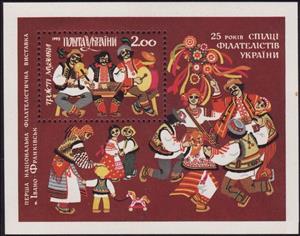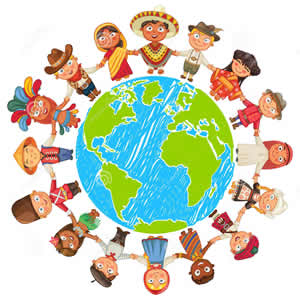Souvenir Sheet: Three musicians. 1st National Philatelic Exhibition (Ukraine 1992)
Three musicians. 1st National Philatelic Exhibition (Ukraine 1992)
19 August (Ukraine ) within release Philatelic exhibitions goes into circulation Souvenir Sheet Three musicians. 1st National Philatelic Exhibition face value 2 Ukrainian karbovanets
| Souvenir Sheet Three musicians. 1st National Philatelic Exhibition in catalogues | |
|---|---|
| Michel: | Mi:UA BL1 |
Souvenir Sheet is horizontal format.
Souvenir Sheet Three musicians. 1st National Philatelic Exhibition it reflects the thematic directions:
Music is an art form and cultural activity whose medium is sound organized in time. The common elements of music are pitch (which governs melody and harmony), rhythm (and its associated concepts tempo, meter, and articulation), dynamics (loudness and softness), and the sonic qualities of timbre and texture (which are sometimes termed the "color" of a musical sound). Different styles or types of music may emphasize, de-emphasize or omit some of these elements. Music is performed with a vast range of instruments and vocal techniques ranging from singing to rapping; there are solely instrumental pieces, solely vocal pieces (such as songs without instrumental accompaniment) and pieces that combine singing and instruments. The word derives from Greek μουσική (mousike; "art of the Muses"). In its most general form, the activities describing music as an art form or cultural activity include the creation of works of music (songs, tunes, symphonies, and so on), the criticism of music, the study of the history of music, and the aesthetic examination of music. Ancient Greek and Indian philosophers defined music as tones ordered horizontally as melodies and vertically as harmonies. Common sayings such as "the harmony of the spheres" and "it is music to my ears" point to the notion that music is often ordered and pleasant to listen to.
A culture is a way of life of a group of people--the behaviors, beliefs, values, and symbols that they accept, generally without thinking about them, and that are passed along by communication and imitation from one generation to the next. Culture is symbolic communication. --the behaviors, beliefs, values, and symbols that they accept, generally without thinking about them, and that are passed along by communication and imitation from one generation to the next. Culture is symbolic communication.
Philately (/fɪˈlætəli/; fih-LAT-ə-lee) is the study of postage stamps and postal history. It also refers to the collection and appreciation of stamps and other philatelic products.While closely associated with stamp collecting and the study of postage, it is possible to be a philatelist without owning any stamps. For instance, the stamps being studied may be very rare or reside only in museums.
Dance is an art form, often classified as a sport, consisting of sequences of body movements with aesthetic and often symbolic value, either improvised or purposefully selected. Dance can be categorized and described by its choreography, by its repertoire of movements or by its historical period or place of origin. Dance is typically performed with musical accompaniment, and sometimes with the dancer simultaneously using a musical instrument themselves.




